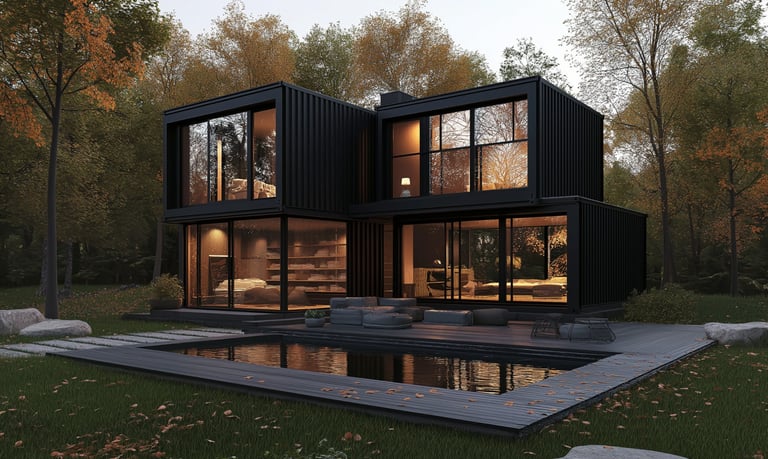How Much Does a Container Home Really Cost in 2025? A Complete Guide


If you’re intrigued by the idea of a container home, you’re not alone. In 2025, container living continues to surge in popularity across the USA, offering a stylish, efficient, and sustainable alternative to traditional housing. Whether you’re planning a cozy backyard studio or a full-fledged modular dwelling, understanding the true costs and potential savings is essential.
This in-depth guide will walk you through every cost component—from shell to finished interior—while sharing tips and real-life experiences to save you time and money. And if you’re looking for ready-to-use container home plans, check out these plans on Etsy. Those plans have been key in helping many navigate building and permitting steps smoothly. ModularPlans ->
1. Shell & Delivery: The Foundation of Your Build
Container Pricing in 2025
40′ high-cube container (used): $4,000–$7,000
20′ standard container (used/new): $2,500–$5,500
Repainted or lightly modified shells: $8,000–$15,000+
Tip from experience: Local port availability heavily influences price. In Seattle or Los Angeles, used containers are cheaper than in landlocked states like Nebraska—plan early to reserve your preferred units.
Delivery & Handling
Freight delivery: $500–$1,500 depending on location, clearance, and crane services.
Placement: If your site has limited access, you may need a mobile crane or hi‑rail flatbed.
Real insight: One builder I consulted with paid an extra $2,000 in Alabama because the delivery truck needed to bring in gravel to support its weight temporarily. Anticipate logistical challenges early.
2. Site Prep & Foundation: Build Smart
Choosing the Right Foundation
Simple pier foundation or gravel pad: $2,000–$5,000 — great for budget builds & good drainage.
Concrete slab (one or two containers): $8,000–$15,000+ — gives clean lines and underfloor insulation.
Basement or crawlspace: $15,000–$25,000+ — more costly, but adds storage/living space.
Plumbing lesson learned: A builder in Arizona who chose pier foundations later added a long plumbing trench to reach septic lines—costing them $4,500. Slab or crawlspace early on can be a better investment.
Soil & Site Considerations
Rocky or sloped terrain may need grading or retaining walls—budget $3,000–$10,000 extra.
Well-drained sites reduce water and termite issues; always consider basic grading.
3. Structural Reinforcement & Modifications
Shipping containers are strong, but modifications for windows/doors require reinforcement and welding.
Cutting & welding per container: $3,000–$7,000
Stitch framing & header support: $2,000–$5,000
Roof tie-ins for multiple containers: $5,000–$12,000+
Homeowner anecdote: One DIY-er underestimated welding work. He paid $9,000 to a pro midbuild after a couple of collapse incidents when installing skylights. Lesson: Hire certified welders from day one.
Tip: Decide your container layout early, even before purchasing. This avoids expensive last-minute welding or additional containers.
4. Insulation, Weatherproofing & Exterior
Insulation Options
Spray foam insulation (closed-cell): $6–$10 per sq ft (~$5,000–$10,000 total)
- Pros: R-value ~7 per inch, air-tight, moisture barrier
- Cons: Higher cost; professional install required
Rigid board insulation + framing: $4,000–$8,000
- Pros: DIY-friendly, recyclable foam-board options
- Cons: Less airtight, needs careful sealing
Insider tip: In cold climates like Montana, spray foam can save $1,200/year on heating compared to rigid board. In warmer climates like Texas, a HFO-blown spray foam (lower GWP, eco-friendlier) is a wise choice.
Exterior Finishes & Cladding
Paint (sandblast + primer + topcoat): $3,000–$7,000
Siding systems (e.g., smart siding, wood paneling): $5,000–$15,000+
Case study: A homeowner in Vermont went with charred cedar siding over their painted containers for added insulation and style—costing $12,000 but increasing home value and durability.
5. Windows, Doors & Entryways
Off-the-shelf windows: $300–$800 each; high-end or insulated options can go up to $1,500+
Exterior doors: $500–$2,000 depending on quality and insulation
Custom steel doors or sliding glass systems: $3,000–$7,000+
Pro tip: Pre-size your windows in your container home plans. A mismatched window opening could lead to expensive custom replacements.
6. Utilities: Electrical, Plumbing & HVAC
Electrical Systems
Rough-in wiring, outlets, and lighting: $5,000–$10,000
Panels and connections to grid: $2,000–$5,000
Solar + battery backup (optional): $10,000–$30,000+
Experience note: One client added solar unaware they’d need a backup generator for peak loads. Having your electrician review the system layout early can prevent inefficiencies.
Plumbing & Septic
Basic plumbing rough-in: $5,000–$12,000
Connect to municipal sewer: $500–$2,500
Septic system in rural areas: $5,000–$15,000+
Tip: In cold climates, always insulate plumbing runs if in crawlspace or above-ground pier foundations.
HVAC & Climate Control
Mini-split HVAC (heat & cool): $8,000–$15,000+
Central HVAC: $6,000–$12,000
Ventilation/HRV units in tight builds (like spray foam): $2,000–$4,000
Reminder from a builder: With tight spray-foam containers, you’ll need a proper ventilation unit. One avoided this step and dealt with humidity issues for years.
7. Interior Finishes & Living Spaces
Flooring & Drywall
Subfloor + laminate/engineered wood/tile: $5–$10 per sq ft → $5,000–$10,000
Drywall or interior paneling: $8–$15 per sq ft → $8,000–$15,000
Tip: If you live in an earthquake zone, opt for plywood paneling over drywall—it resists cracking during stress.
Kitchen & Bath
Basic kitchen (cabinets, countertops, appliances): $8,000–$15,000
Premium kitchen setups: $20,000+
Bathroom (basic): $5,000–$12,000 — includes topology of fixtures, shower, vanity
DIY insight: Even a 2×2 container house need not skimp on quality. One builder squeezed their appliances in a 6×8 galley kitchen and paid extra for a custom tile backsplash—but it gave big-living feel and resale value.
Paint & Trim
Interior painting (DIY or pro): $3,000–$6,000
Casings, handrails, trim: $2,000–$5,000
8. Permits, Design & Professional Services
Professional Design Fees
Architect or engineer: $3,000–$7,000 (depends on complexity)
Ready-made container home plans (ideal for small to mid-sized builds): $60–$200
“Purchased plans saved me $8,000 in drafting time, and the structural drawings prevented a scrap of unpermitted steel,” shares one U.S. container‑home builder.
Recommendation: If you want professional guidance beyond plans, I strongly recommend working with qualified engineers who specialize in container structures, like BoxHausDesigns (partner with container-focused portfolios). These professionals have ample experience navigating U.S. codes, optimizing structural reinforcements, and producing drawings that pass local inspections the first time — saving you costly delays and frustration.
Permitting & Inspection Costs
Building permits: $500–$5,000
Zoning modifications or provisos: $1,000–$4,000
Inspection costs: $300–$1,200
Tip: Call your county’s planning office early. Some areas only allow 15’ tall homes; others don’t allow stacking more than two containers. Accurate plans prevent costly rework.
9. Total 2025 Cost Snapshot
For a compact studio or accessory dwelling unit (ADU) built with a single container, typically ranging between 320 and 400 square feet, you should budget around $60,000 to $90,000. This includes the container shell, foundation, insulation, interior finishes, and utility hookups, but not necessarily the cost of the land.
If you’re looking to build a mid-size two-bedroom container house, around 600 to 800 square feet, you can expect to spend between $100,000 and $150,000 in 2025. This price covers moderate finishes, a comfortable kitchen and bath, and standard utility connections.
For a larger modular multi-unit container home, measuring roughly 1,000 to 1,600 square feet, the budget can reach $150,000 to $300,000 or more depending on finishes, customization, and whether you incorporate off-grid systems like solar or rainwater catchment.
Case example: A couple in Colorado built a two-container, two-bedroom ADU (about 600 square feet) in 2025. They spent $9,000 on the containers themselves, $12,000 on a slab foundation, $7,500 on spray-foam insulation, $24,000 on plumbing, electrical, and HVAC, $18,000 on finishes, and $6,000 on permits and professional fees. Altogether, their build came in around $76,500, excluding the cost of their land.
10. Real-World Tips & Insider Wisdom
Start with Phase 1 – When uncertain, go for a smaller first unit. You learn zone rules, the site, and your long-term vision before deeper investment.
DIY where it counts – Painting, simple finish work, and cabinetry doors can be DIY-friendly; leave welding, electrical, and HVAC to pros.
Use modular design – Plan container configurations that let you add more units in the future—staircases and tie-ins can be prepped early.
Order containers nearby – Local pickup can save thousands; check local steel yards and Craigslist/forums for competitive prices.
Embrace sustainable options – Rainwater collection, solar, reclaimed materials—these often qualify for rebates or tax credits.
Optimize orientation – North/South orientation reduces heat gain; shade with a simple overhang or pergola.
Plan for moisture – Use vapor barriers, grading for slope, and gutter systems to protect the metal shell.
11. Why Professional Plans Pay Off
DIY drafts often lack structural, HVAC, or plumbing detail needed for permits. That’s why these container home plans on Etsy include:
Full floor plans and framing layout
Electrical and plumbing schematics
Notes on insulation systems, window placements, ventilation
Permit-ready documentation for many U.S. counties
They’ve proven to save both time and money during the permitting process.
12. Comparing Costs: Traditional vs. Container Builds
In the United States, a traditional wood-framed home in 2025 typically costs between $150 and $250 or more per square foot, with a construction timeline ranging from 6 to 12 months. These homes generally have a higher environmental impact because they require more new materials and produce greater amounts of construction waste.
In comparison, a container home averages around $100 to $180 per square foot, with a shorter build time of roughly 4 to 8 months. Because shipping containers repurpose existing steel structures, they tend to have a smaller carbon footprint and contribute far less to landfill waste.
Even on the higher end of the container home budget, you can still see cost and time savings of about 20 to 40 percent compared to conventional homes. When you add in the possibility of financing through green bonds, rural housing programs, or even certain VA loan programs, container homes in 2025 offer an appealing, sustainable, and budget-smart alternative to traditional builds.
13. Long-Term Value & Resale
Properly built container homes hold value—especially if sited legally and designed to code.
They attract niche buyers (eco-minded individuals, downsizers, Airbnb investors).
Modular layout can be added onto—great for staged investment.
Success story: One container home in Portland sold in 2024 for $180,000 after being built for $120,000—thanks to efficient planning, attractive finishes, and excellent local marketing.
14. Choosing the Right Financing
Construction loans convert to mortgages; rates ~4–6% in 2025
Green mortgage programs—like FHA PowerSaver—may offer lower rates for eco-builds
Self-build mortgages or renovation loans can cover container-based projects
Crowdfunding or cooperative equity schemes help for communal or innovative designs
Tip: Bring complete container home plans and cost estimates to lenders early—they’re more comfortable with well-documented builds.
Final Takeaways
A container house in USA in 2025 isn’t just an alternative home—it’s a statement of efficiency, sustainability, and smart investment. Here’s your quick checklist:
Establish your budget: $60k–$300k+ depending on scale
Gather ready-to-go plans (see my Etsy shop!)
Understand your site’s foundation and utility needs
Phase your project to limit upfront costs
Hire professionals for structural, electrical, and HVAC
DIY appropriately—your sweat equity boosts value
Explore rebates for green building, solar, water savings
By understanding each cost component—from containers and foundations to finishes and permits—you’ll make informed decisions that build value and minimize waste. And with trusted, U.S.-compliant container home plans at your fingertips, you’re well on your way to a simpler, smarter, and sustainable future.
